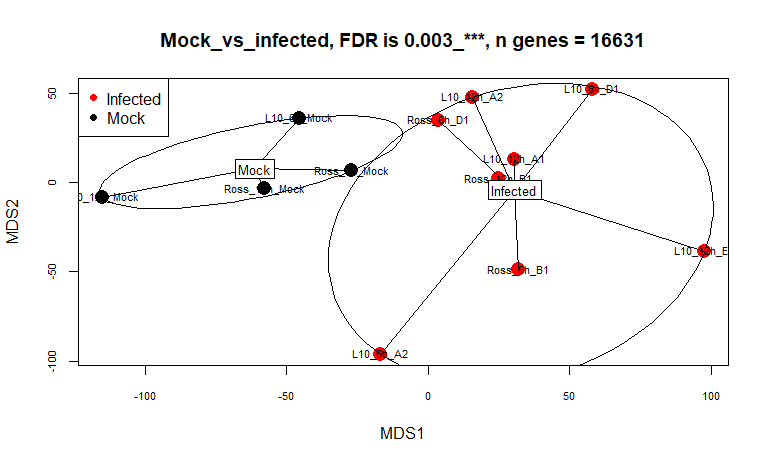I am running EdgeR pipeline on an RNA seq data comparing two condition (mock; 2 samples vs infected ; 10 samples) while adjusting for time points. I normalized using TMM method, and then fitted generalized linear model (glmQLFit) on the data and then run DE test using (glmQLFTest)
When I checked the summary of the decideTests, no genes were sig DE at 0.05 or even 0.1 cutoff. I looked into toptag function to look at the adj.pvalue and found they are all identical and close to 1. So, this was the reason of no sig. genes retrieved. I have also tried all the P.adj methods, they gave the same results. I have calculated adj p-value manually using function (p.unadju), they gave the same results. May be because of the 2 biological replicates vs 10 replicates is reducing the sig. DE power ?
Any explanation of why do I get identical adj. p value ? although P-values are different ? Can I use P-values for sig DE genes at 0.05 ?
My code:
# Convert filtered raw counts to DGEList list
L10_dgeObj <- DGEList(L10_counts.keep)
# TMM normalization
L10_dgeObj <- calcNormFactors(L10_dgeObj)
# create design matrix to compare the two levels of Status ( Mock, infected) and adjust for time points
L10_design <- model.matrix(~Time_point+Status)
# dispersion estimation
L10_y <- estimateDisp(L10_dgeObj, L10_design)
L10_y$common.dispersion
L10_y$trended.dispersion
Tagwisedie<- L10_y$tagwise.dispersion
# instaling statmod package helps to robustness the DE model
install.packages('statmod')
library('statmod')
# fitting the linear model.Robust = TRUE
L10_fit<- glmQLFit(L10_y, L10_design, robust = TRUE)
# running the DE test
L10_tr <- glmQLFTest(L10_fit, coef = "StatusInfected")
# get summary of decideTest
summary(decideTests(L10_tr))
# Get list of top sig DE gene based on adj. pvalue
topTags(L10_tr, n = 15420, adjust.method = 'BH', sort.by = 'PValue', p.value = 0.05)
Session Info:
R version 4.2.3 (2023-03-15 ucrt)
Platform: x86_64-w64-mingw32/x64 (64-bit)
Running under: Windows 10 x64 (build 19045)
Matrix products: default
locale:
[1] LC_COLLATE=English_United Kingdom.utf8 LC_CTYPE=English_United Kingdom.utf8
[3] LC_MONETARY=English_United Kingdom.utf8 LC_NUMERIC=C
[5] LC_TIME=English_United Kingdom.utf8
attached base packages:
[1] stats graphics grDevices utils datasets methods base
other attached packages:
[1] vegan_2.6-4 lattice_0.21-8 permute_0.9-7 xlsx_0.6.5
[5] statmod_1.5.0 readxl_1.4.3 BiocManager_1.30.22 edgeR_3.40.2
[9] metagenomeSeq_1.40.0 RColorBrewer_1.1-3 glmnet_4.1-8 Matrix_1.6-0
[13] limma_3.54.2 Biobase_2.60.0 BiocGenerics_0.44.0
loaded via a namespace (and not attached):
[1] Rtsne_0.16 colorspace_2.1-0 ellipsis_0.3.2 XVector_0.38.0
[5] fs_1.6.3 rstudioapi_0.15.0 remotes_2.4.2.1 fansi_1.0.4
[9] codetools_0.2-19 splines_4.2.3 cachem_1.0.8 knitr_1.44
[13] pkgload_1.3.2.1 ade4_1.7-22 jsonlite_1.8.7 phyloseq_1.44.0
[17] rJava_1.0-6 cluster_2.1.4 shiny_1.7.5 compiler_4.2.3
[21] fastmap_1.1.1 cli_3.6.1 later_1.3.1 htmltools_0.5.5
[25] prettyunits_1.1.1 tools_4.2.3 igraph_1.5.1 gtable_0.3.4
[29] glue_1.6.2 GenomeInfoDbData_1.2.9 reshape2_1.4.4 dplyr_1.1.2
[33] Rcpp_1.0.11 cellranger_1.1.0 vctrs_0.6.3 Biostrings_2.66.0
[37] rhdf5filters_1.10.1 multtest_2.54.0 ape_5.7-1 nlme_3.1-162
[41] iterators_1.0.14 xfun_0.40 stringr_1.5.0 xlsxjars_0.6.1
[45] ps_1.7.5 mime_0.12 miniUI_0.1.1.1 lifecycle_1.0.3
[49] gtools_3.9.4 devtools_2.4.5 zlibbioc_1.44.0 MASS_7.3-60
[53] scales_1.2.1 promises_1.2.1 parallel_4.2.3 biomformat_1.26.0
[57] rhdf5_2.42.1 yaml_2.3.7 memoise_2.0.1 gridExtra_2.3
[61] ggplot2_3.4.3 stringi_1.7.12 S4Vectors_0.36.2 foreach_1.5.2
[65] caTools_1.18.2 pkgbuild_1.4.2 shape_1.4.6 GenomeInfoDb_1.34.9
[69] rlang_1.1.1 pkgconfig_2.0.3 matrixStats_1.0.0 bitops_1.0-7
[73] Wrench_1.16.0 evaluate_0.21 purrr_1.0.2 Rhdf5lib_1.20.0
[77] htmlwidgets_1.6.2 tidyselect_1.2.0 processx_3.8.2 plyr_1.8.8
[81] magrittr_2.0.3 R6_2.5.1 IRanges_2.32.0 gplots_3.1.3
[85] generics_0.1.3 profvis_0.3.8 pillar_1.9.0 mgcv_1.9-0
[89] survival_3.5-5 RCurl_1.98-1.12 tibble_3.2.1 crayon_1.5.2
[93] KernSmooth_2.23-22 utf8_1.2.3 microbiome_1.20.0 rmarkdown_2.24
[97] urlchecker_1.0.1 usethis_2.2.2 locfit_1.5-9.8 grid_4.2.3
[101] data.table_1.14.8 callr_3.7.3 digest_0.6.33 xtable_1.8-4
[105] tidyr_1.3.0 httpuv_1.6.11 stats4_4.2.3 munsell_0.5.0
[109] sessioninfo_1.2.2



Regarding identical values of
adj.P.Val, you may want to see this post and link: Limma adj.p.value the same for many different p.valuesI went through this, but what I got is that this is normal. Does this now means I do not have any sig DE genes at 0.05 based on adj.P value ?
Thanks